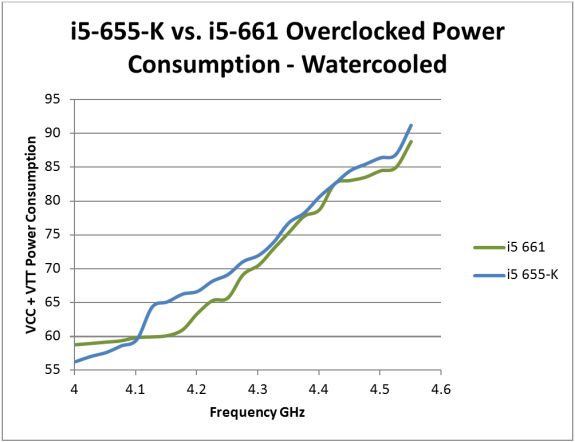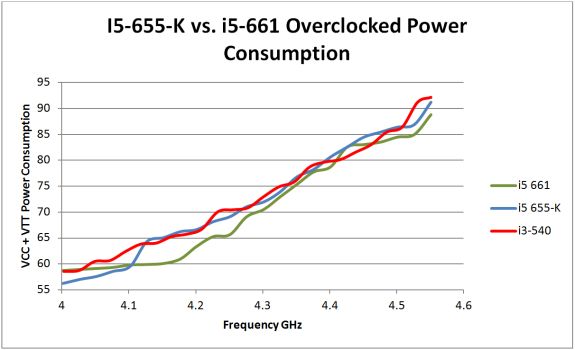i3-540 vs. i5-655K vs. i5-661
Next up, let’s take a look at the power scaling of the i5-665K against the more expensive albeit locked multiplier variant, the i5-661:

We’ve started the scale at 4GHz here, because any variance below this freqeuncy using water-cooling is negligible (around 2W in favour of the i5-655-K due to a lower VTT). The biggest gap we could find over 4GHz is 7 Watts which shows up between 4.1GHz and 4.2GHz where our i5-655K sample needs a rapid hike of VTT to scale. After that, there’s a 2~4W variance at equivalent frequencies favouring the i5-661 - not huge by any means over the frequency band of interest for overclockers using air or water cooling.
At this point, we’ll overlay the i3-540 power consumption figures using the same water-loop for cooling:
With good cooling, the i3-540 is plenty overclockable.
The i3-540 is at an “advantage” in this graph, as we’ve got no choice but to lower the memory multiplier ratio to 2:8 (giving a speed of DDR-3 1584 MHz at 4.554GHz). The i3-540 has a maximum core multiplier of 23x, and given the base clock needed to attain 4.55GHz, we’d be close to DDR3-2000 speeds which is a tall order for this particular CPU. Both the i5-661 and i5-655K are running the 2:10 memory multiplier ratio using a 25x CPU core mutliplier, giving a memory speed of DDR3-1820.
Before we have a quick look at the Lynnfield i7-875-K, one last thing we’d like to compare is how well the i5-655K handles sub-zero temperatures in comparison to the i5-661.
The capabilities of the i5-661 are well known to us, and we’ve already got a number of overclocking results on record to compare against. Given the i5-661 exhibits better frequency scaling relative to applied voltage, it’ll be interesting to see how the i5-655K fares…












51 Comments
View All Comments
Ph0b0s - Friday, May 28, 2010 - link
Not covered so much on these websites but I slurged on an I7 965 when I7's were new, becuase it was unlocked, even though I knew it did not have any extra head room than the cheap chips in the family. The reason I did this was so that I could use the I7's new turbo feature to overclock on demand instead of having to use static timings to overclock. With unlocked I7's and the right motherboard you can change the value of the turbo mulipliers to be more than just one or two steps.So for my chip if I have all 4 cores in use my turbo muliplier is set to x29 (3800 ghz, only using factory voltages at the moment) and higher amounts when less cores are in use. So when not doing anything my CPU clocks itself to 1.6 GHz and runs at 3.2 GHz if not doing too much and then clocks itself to 3.8GHz when extra power is needed.
So I really welcome Intel putting out these cheaper unlocked CPU's, as next time when I want to overclock using the turbo funtionality I won't have to fork out for an Extreme Edition again.
Also I would love to see more coverage of this type of overclocking that it is new with the Nathelems, Before it was only the I7 Extreme Edition chips that could do it, but now that are more options avaliable, maybe Anandtech could do an article taking about it.
Death666Angel - Friday, May 28, 2010 - link
Hello guys!I was really looking forward to Intel -K material. But the whole bunch of "i5 540" is more than an annoyance. It is downright embarrassing and I would urge you to re-read any future texts, as I am really not interested in reading stuff when so little time is put into the text. Really a shame since the content is looking good.
Rajinder Gill - Friday, May 28, 2010 - link
Sorry, blame me for that. Those skipped under the radar this morning.-Raja
Griswold - Friday, May 28, 2010 - link
If you wonder why Intel does this, it most likely boils down to two letters: BE. They were never priced as if they came straight out of Absurdistan. And perhaps Intel felt a little itch because of that...Maroon - Friday, May 28, 2010 - link
^^^we have a winner!DanNeely - Friday, May 28, 2010 - link
Where are you getting those numbers from? Software or are you using hardware to measure it directly off the mobo itself?Rajinder Gill - Friday, May 28, 2010 - link
Hardware measured using a clamp meter.Raja
DanNeely - Sunday, May 30, 2010 - link
So you were measuring the current going into the mobo via the 4/8pin 12V cpu power cable?Rajinder Gill - Monday, May 31, 2010 - link
Yes.DanNeely - Tuesday, June 1, 2010 - link
Did you also monitor the main ATX power connector to see if there was any increase in power draw there when overclocking?